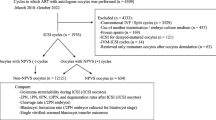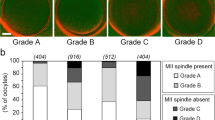Abstract
Purpose : The presence of a clear half-moon-like zone of cytoplasm in oocytes is called “halo effect.” The prognostic value of this effect is not yet determined. Aligned nucleoli in pronuclei (PN) represent a further polarization phenomenon and a marker for implantation potential. Aim of the prospective study was to evaluate the influence of the halo effect on IVF outcome and to compare the results with observed polarization in PN.
Methods : A total of 374 cycles with embryonic transfer were analyzed regarding halo effect and pattern of nucleoli. The oocytes were single-cultured to observe the following embryo quality of each PN stage.
Results : Cycles with halo-positive oocytes showed a significant higher pregnancy rate (44.0% vs. 31.1%; p < 0.05). Furthermore, higher pregnancy rates in cycles with polarized nucleoli were observed. Polarized PN resulted in a significant lower fragmentation and higher cleavage rate of embryos. The fragmentation rate was significantly lower in halo+ oocytes, but the cleavage rate was not influenced.
Conclusions : The results indicate that the presence of a polarized zone of human fertilized oocytes can be a useful indicator for good oocyte quality. Since the origin of ooplasmic polarization seems to be a different process compared with the alignment of nucleoli, the observation will give additional predictive information about the implantation potential.
Similar content being viewed by others
REFERENCES
Denker HW: Cell lineage, determination and differentiation in earliest developmental stages in mammals. Biblog Anat 1983;24:22-58
Gardner RL: Polarity in early mammalian development. Curr Opin Genet Dev 1999;9:417-421
Gardner RL: Scrambled or bisected mouse eggs and the basis of patterning in mammals. Bioessays 1999;21:271-274
Selwood L: Mechanisms for pattern formation leading to axis formation and lineage allocation in mammals:Amarsupial perspective. Reproduction 2001;5:677-683
Edwards RG, Beard HK: Oocyte polarity and cell determination in early mammalian embryos. Mol Hum Reprod 1997;10:863-905
Edwards RG: The role of embryonic polarities in preimplantation growth and implantation of mammalian embryos. Hum Reprod 2000;15(Suppl 6):1-8
Scott LA: Oocyte and embryo polarity. Sem Reprod Med 2000;18:171-183
Van Blerkom J, Davis P: Evolution of the sperm aster after microinjection of isolated human sperm centrosomesinto meiotically mature human oocytes. Hum Reprod 1995;10:2179-2182
Serhal PF, Ranieri DM, Kinis A, Marchant S, Davies M, Khadum IM: Oocyte morphology predicts outcome of intracytoplasmic sperm injection. Hum Reprod 1997;12:1267-1270
Scott LA, Smith S: The successful use of pronuclear embryo transfers in the day following oocyte retrival. Hum Reprod 1998;13:1003-1013
Tesarik J, Greco E: The probability of abnormal preimplantation development can be predicted by a single static observation on pronuclear stage morphology. Hum Reprod 1999;14:1318-1323
Steer CV, Mills CL, Tan SL, Campbell S, Edwards RG: The cumulative embryo score:Apredictive embryoscoring technique to select the optimal number of embryos to transfer in an invitro-fertilization and embryo transfer program. Hum Reprod 1992;7:117-119
Koyama H, Suzuki H, Yang X, Jiang S, Foote RH: Analysis of polarity of bovine and rabbit embryos by scanning electron microscopy. Biol Reprod 1994;50:163-170
Santella L, Alikani M, Talansky BE, Cohen J, Dale B: Is the human oocyte plasma membrane polarized? Hum Reprod 1992;7:999-1003
Calarco PG: Polarization of mitochondria in the unfertilized mouse oocyte. Dev Genet 1995;16:36-43
Antczak M, Van Blerkom J: Temporal and spartial aspects of fragmentation in early human embryos: Possible effects on developmental competence and association with the differential elimination of regulatory proteins from polarized domains. Hum Reprod 1999;14:429-447
van der Ven H, Montag M: Multicentre-study to determine the possible correlation between pronuclear morphology and success or ART treatment. Hum Reprod 2001;16(Abstract Book 1):7
Author information
Authors and Affiliations
Corresponding author
Rights and permissions
About this article
Cite this article
Stalf, T., Herrero, J., Mehnert, C. et al. Influence of Polarization Effects in Ooplasma and Pronuclei on Embryo Quality and Implantation in an IVF Program. J Assist Reprod Genet 19, 355–362 (2002). https://doi.org/10.1023/A:1016300703430
Issue Date:
DOI: https://doi.org/10.1023/A:1016300703430




